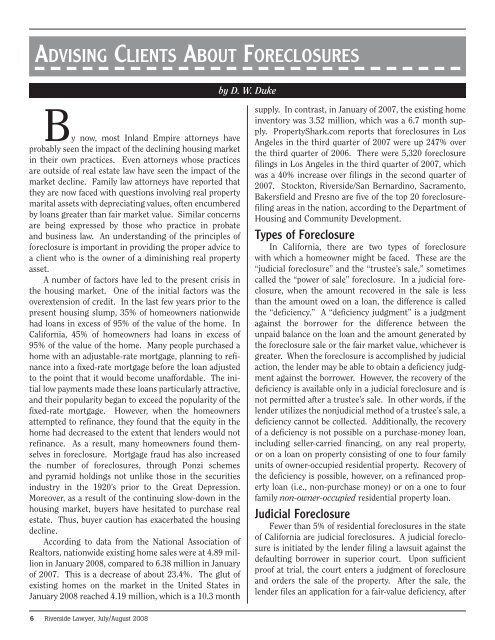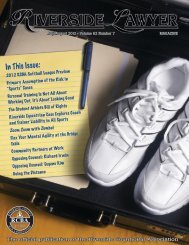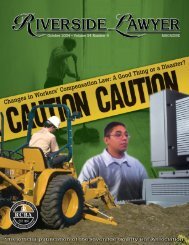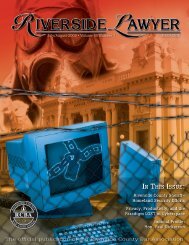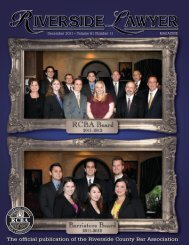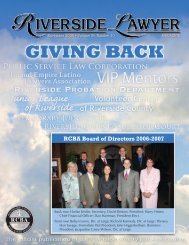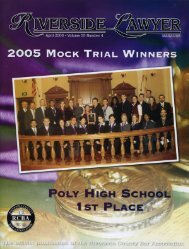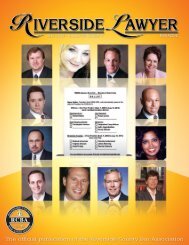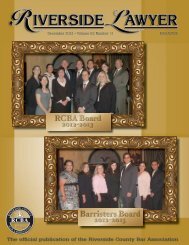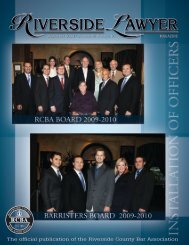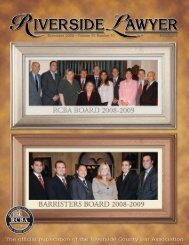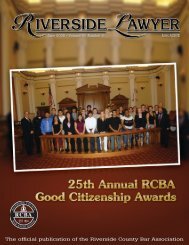IN THIS ISSUE: - Riverside County Bar Association
IN THIS ISSUE: - Riverside County Bar Association
IN THIS ISSUE: - Riverside County Bar Association
You also want an ePaper? Increase the reach of your titles
YUMPU automatically turns print PDFs into web optimized ePapers that Google loves.
Advising Clients About Foreclosures<br />
by D. W. Duke<br />
By now, most Inland Empire attorneys have<br />
probably seen the impact of the declining housing market<br />
in their own practices. Even attorneys whose practices<br />
are outside of real estate law have seen the impact of the<br />
market decline. Family law attorneys have reported that<br />
they are now faced with questions involving real property<br />
marital assets with depreciating values, often encumbered<br />
by loans greater than fair market value. Similar concerns<br />
are being expressed by those who practice in probate<br />
and business law. An understanding of the principles of<br />
foreclosure is important in providing the proper advice to<br />
a client who is the owner of a diminishing real property<br />
asset.<br />
A number of factors have led to the present crisis in<br />
the housing market. One of the initial factors was the<br />
overextension of credit. In the last few years prior to the<br />
present housing slump, 35% of homeowners nationwide<br />
had loans in excess of 95% of the value of the home. In<br />
California, 45% of homeowners had loans in excess of<br />
95% of the value of the home. Many people purchased a<br />
home with an adjustable-rate mortgage, planning to refinance<br />
into a fixed-rate mortgage before the loan adjusted<br />
to the point that it would become unaffordable. The initial<br />
low payments made these loans particularly attractive,<br />
and their popularity began to exceed the popularity of the<br />
fixed-rate mortgage. However, when the homeowners<br />
attempted to refinance, they found that the equity in the<br />
home had decreased to the extent that lenders would not<br />
refinance. As a result, many homeowners found themselves<br />
in foreclosure. Mortgage fraud has also increased<br />
the number of foreclosures, through Ponzi schemes<br />
and pyramid holdings not unlike those in the securities<br />
industry in the 1920’s prior to the Great Depression.<br />
Moreover, as a result of the continuing slow-down in the<br />
housing market, buyers have hesitated to purchase real<br />
estate. Thus, buyer caution has exacerbated the housing<br />
decline.<br />
According to data from the National <strong>Association</strong> of<br />
Realtors, nationwide existing home sales were at 4.89 million<br />
in January 2008, compared to 6.38 million in January<br />
of 2007. This is a decrease of about 23.4%. The glut of<br />
existing homes on the market in the United States in<br />
January 2008 reached 4.19 million, which is a 10.3 month<br />
supply. In contrast, in January of 2007, the existing home<br />
inventory was 3.52 million, which was a 6.7 month supply.<br />
PropertyShark.com reports that foreclosures in Los<br />
Angeles in the third quarter of 2007 were up 247% over<br />
the third quarter of 2006. There were 5,320 foreclosure<br />
filings in Los Angeles in the third quarter of 2007, which<br />
was a 40% increase over filings in the second quarter of<br />
2007. Stockton, <strong>Riverside</strong>/San Bernardino, Sacramento,<br />
Bakersfield and Fresno are five of the top 20 foreclosurefiling<br />
areas in the nation, according to the Department of<br />
Housing and Community Development.<br />
Types of Foreclosure<br />
In California, there are two types of foreclosure<br />
with which a homeowner might be faced. These are the<br />
“judicial foreclosure” and the “trustee’s sale,” sometimes<br />
called the “power of sale” foreclosure. In a judicial foreclosure,<br />
when the amount recovered in the sale is less<br />
than the amount owed on a loan, the difference is called<br />
the “deficiency.” A “deficiency judgment” is a judgment<br />
against the borrower for the difference between the<br />
unpaid balance on the loan and the amount generated by<br />
the foreclosure sale or the fair market value, whichever is<br />
greater. When the foreclosure is accomplished by judicial<br />
action, the lender may be able to obtain a deficiency judgment<br />
against the borrower. However, the recovery of the<br />
deficiency is available only in a judicial foreclosure and is<br />
not permitted after a trustee’s sale. In other words, if the<br />
lender utilizes the nonjudicial method of a trustee’s sale, a<br />
deficiency cannot be collected. Additionally, the recovery<br />
of a deficiency is not possible on a purchase-money loan,<br />
including seller-carried financing, on any real property,<br />
or on a loan on property consisting of one to four family<br />
units of owner-occupied residential property. Recovery of<br />
the deficiency is possible, however, on a refinanced property<br />
loan (i.e., non-purchase money) or on a one to four<br />
family non-owner-occupied residential property loan.<br />
Judicial Foreclosure<br />
Fewer than 5% of residential foreclosures in the state<br />
of California are judicial foreclosures. A judicial foreclosure<br />
is initiated by the lender filing a lawsuit against the<br />
defaulting borrower in superior court. Upon sufficient<br />
proof at trial, the court enters a judgment of foreclosure<br />
and orders the sale of the property. After the sale, the<br />
lender files an application for a fair-value deficiency, after<br />
6 <strong>Riverside</strong> Lawyer, July/August 2008


